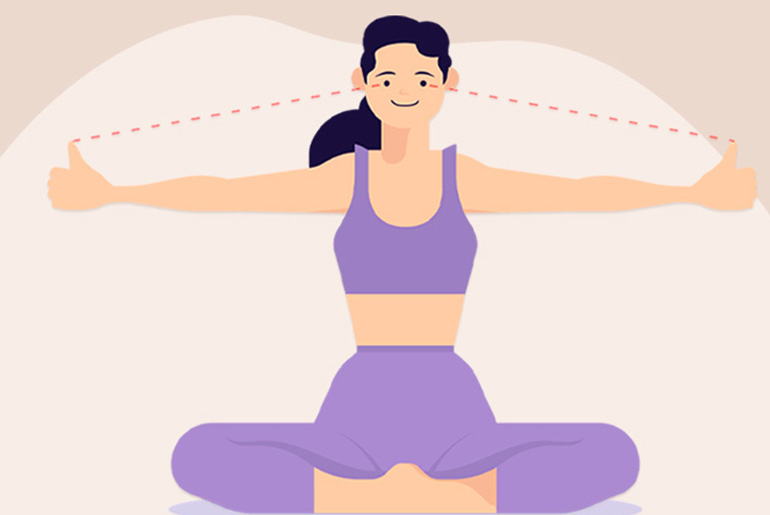In recent years, eye yoga exercises have gained attention for their purported benefits in strengthening eye muscles and improving vision and overall eye health. This article explores the roots of eye yoga, its potential benefits, and the existing research supporting its efficacy. It delves into various eye yoga exercises and provides instructions on how to perform them. Additionally, common questions surrounding this topic are addressed, offering readers a comprehensive understanding of eye yoga and its potential impact on eye health and vision.
What is Eye Yoga?
Eye yoga is a practice that focuses on exercises and techniques to improve eye health naturally. Here’s a breakdown of what it is and how it works:
- Definition: Eye yoga involves simple exercises aimed at working, strengthening, and preparing the muscles in the eyes. These exercises typically include focusing on objects at varying distances, as well as moving the eyes in different directions without moving the head or neck. The goal is to enhance the strength and flexibility of the eye muscles, as well as to promote relaxation and improve focus.
- Ancient Origins: Eye yoga has its roots in ancient Indian practices, particularly Hatha Yoga. Hatha Yoga emphasizes physical postures, breath control, and mental relaxation. Similarly, eye yoga focuses on physical movements and techniques to promote eye health, along with relaxation and calmness.
- Modern Interpretations: In today’s digital age, where people spend extended periods staring at screens, eye yoga has gained renewed attention. With increased screen time comes issues like eye strain and digital eye fatigue. As a result, eye yoga has evolved to address these modern challenges while still drawing from traditional practices. Modern interpretations of eye yoga often incorporate exercises specifically designed to alleviate eye strain caused by screen use and promote overall eye health in the digital era.
Overall, eye yoga offers a holistic approach to maintaining and improving eye health by incorporating exercises and techniques to strengthen the eye muscles, reduce strain, and promote relaxation. It’s a natural and gentle way to care for your eyes in today’s technology-driven world.
Research on eye yoga:
Research on eye yoga is still emerging, and while some studies suggest potential benefits for certain eye issues, the evidence remains limited. Here’s an overview of the scientific evidence and the limitations of current research:
- Scientific Evidence: Studies investigating the effects of eye yoga have yielded mixed results. Some research suggests that eye yoga may help manage eye strain, improve focus, and promote relaxation. However, there is insufficient evidence to support claims that it can significantly improve vision or address other eye issues.
- Limitations of Studies: Many of the studies on eye yoga have had small sample sizes and lacked control groups, which limits the strength of their findings. Additionally, the methodologies employed in these studies varied, making it challenging to draw definitive conclusions about the efficacy of eye yoga. To establish a clearer understanding of its benefits, further research involving larger and better-designed studies is necessary.
Overall, while preliminary research indicates potential benefits of eye yoga for managing eye strain and promoting relaxation, more robust scientific evidence is needed to confirm these findings and determine its efficacy for addressing various eye issues.
Benefits of Eye Yoga:
Eye yoga is believed to offer various benefits for eye health and overall well-being. Here’s a detailed summary of the proposed benefits:
Improvement of Eyesight:
- Eye yoga may strengthen eye muscles, potentially improving eyesight and reducing reliance on glasses or contact lenses.
- It could prevent vision deterioration by keeping eye muscles flexible and strong, reducing issues like nearsightedness, farsightedness, or astigmatism.
Glaucoma Management:
- Eye yoga may help manage glaucoma by potentially reducing intraocular pressure (IOP), thus lowering the risk and slowing down the progression of the condition.
- While more scientific studies are needed to confirm these benefits, eye yoga may be considered as a complementary approach to traditional therapies recommended by eye doctors.
Dry Eye Relief:
- Eye yoga may provide relief from dry eye symptoms by promoting tear production and moisturizing the eye surface through blinking and relaxation techniques.
- Further research is required to substantiate these claims, but eye yoga could offer short-term relief for dry eye discomfort.
Post-Cataract Surgery Recovery:
- Eye yoga might aid in the restoration of tissues and strengthen eye muscles after cataract surgery, potentially reducing recovery time and providing comfort.
- It’s essential to consult with an eye doctor before incorporating eye yoga into the post-surgery recovery routine.
Dark Circles and Under-Eye Bags:
- Eye yoga exercises, by working the eye muscles and promoting blood flow around the eyes, may help reduce the appearance of dark circles and under-eye bags.
- These benefits require more scientific evidence for validation.
Eye Strain Management:
- In today’s digital age, eye strain is prevalent due to increased screen time. Eye yoga can help reduce the effects of prolonged screen use by encouraging breaks and eye movements.
- By enhancing focus and relaxation, eye yoga may alleviate eye strain and associated problems such as headaches, blurred vision, and dry eyes.
While these proposed benefits show promise, more scientific research is necessary to validate the efficacy of eye yoga. It’s essential to approach eye yoga as a complementary practice to conventional eye care and consult with a healthcare professional for personalized advice.
Eye yoga exercises:
Eye yoga exercises are simple movements aimed at improving eye health, reducing strain, and promoting relaxation. Here’s a detailed guide to some common eye yoga exercises that you can practice at home or in the office:
- Focus Shifting:
Purpose: Boost flexibility and balance of eye muscles, reduce eye tiredness and strain during close tasks.
Guide:
- Sit up straight and lift your left arm in front with the thumb up.
- Follow the thumb with your eyes as it moves slowly to the right, keeping the head still.
- Repeat the movement, then switch arms and repeat for the other eye.
2. Eye Rolling:
Purpose: Ease tightness in eye muscles, relieve eye strain, and promote relaxation.
Guide:
- Sit comfortably, take a deep breath, and look up without moving your head.
- Slowly roll your eyes clockwise while breathing deeply, then pause and roll them in the opposite direction.
- Repeat several times.
3. Palming:
Purpose: Create a calming effect, ease eye strain, and promote relaxation.
Guide:
- Rub your hands together to warm your palms, then close your eyes and place the palms over your eyes without pressure.
- Take deep breaths and focus on the darkness, resting the fingers on your forehead and the lower part of your hands on your cheeks.
- Continue for a few minutes until you feel calmer and more relaxed.
4. Blinking:
Purpose: Moisturize the eyes, reduce discomfort from dry eye, and improve alertness during screen use.
Guide:
- Sit up straight, open your eyes wide, and perform 10 to 15 fast blinks.
- Close your eyes and take deep breaths, then repeat the process three to five times.
5. Figure Eight:
Purpose: Boost flexibility and teamwork of eye muscles, reduce eye strain.
Guide:
- Sit or stand comfortably and imagine a figure-eight on the floor about 10 feet away.
- Follow the path of the figure-eight with your eyes in clockwise and counterclockwise directions.
- Repeat for several repetitions.
6. Near and Far Focus:
Purpose: Strengthen eye muscles, improve focusing ability for near and far objects.
Guide:
- Hold one arm out with the thumb pointing upwards and focus both eyes on the thumb.
- Slowly move the arm towards the nose while keeping the head still, then return to the start.
- Repeat the process for 10 to 20 times.
7. Focusing:
Purpose: Improve pinpoint accuracy of near and distant vision, enhance focus during tasks.
Guide:
- Stretch one arm out in front with the thumb pointing upwards and fixate on the thumb.
- Take a deep breath and move the thumb towards the face while keeping the eyes focused on it.
- Repeat the process for 5 to 10 times.
Practice these eye yoga exercises regularly to promote eye health, reduce strain, and enhance relaxation.
Additional Tips for Eye Health:
In addition to practicing eye yoga, maintaining overall eye health involves incorporating various habits and lifestyle choices. Here are some additional tips for keeping your eyes healthy and addressing vision-related issues:
- Regular Eye Exams:
Schedule regular eye exams with an eye care professional to detect any eye problems early on. These exams ensure that you are using the correct prescription for glasses or contact lenses and can help identify any potential issues that may require further attention.
- Sunglasses and Protective Eyewear:
Protect your eyes from harmful UV rays by wearing sunglasses that block both UVA and UVB rays when outdoors. Additionally, use cCombatting Digital Eye Strain: Effective Tips for Managing Screen Time Impact during activities or occupations that pose a risk of eye injury.
- Reducing Eye Strain:
Follow the 20-20-20 rule: Every 20 minutes, take a break from screens or close tasks and look at an object that is at least 20 feet away for 20 seconds. This practice can help alleviate eye strain caused by prolonged screen time or close-up work.
- Quitting Smoking:
Smoking increases the risk of various eye problems, including age-related macular degeneration and cataracts. Quitting smoking can significantly reduce these risks and contribute to overall eye health.
- Healthy Diet and Hydration:
Maintain a balanced diet rich in nutrients that support eye health, such as vitamins A, C, and E, zinc, and omega-3 fatty acids. Incorporate foods like leafy greens, fish, nuts, and fruits into your diet. Additionally, staying well-hydrated is essential for maintaining proper eye function and moisture levels.
By incorporating these habits into your lifestyle along with practicing eye exercises, you can support and maintain optimal eye health, reduce the risk of eye problems, and promote overall well-being.
Eye yoga exercises offer potential benefits such as alleviating eye strain, enhancing focus, and inducing relaxation. While further scientific evidence is needed to fully support these claims, incorporating these simple movements into daily routines can be beneficial for addressing various eye-related issues. By combining eye yoga exercises with regular eye exams, wearing protective eyewear like sunglasses, maintaining a healthy diet, staying hydrated, and avoiding smoking, individuals can take proactive steps to preserve their eye health. It’s essential to consult with an eye doctor before integrating these exercises into your routine to ensure they are suitable for your specific needs and conditions.
Disclaimer:
The information contained in this article is for educational and informational purposes only and is not intended as a health advice. We would ask you to consult a qualified professional or medical expert to gain additional knowledge before you choose to consume any product or perform any exercise.








